Infrastructure in
America
Preservation and Redevelopment in Post-Katrina Mississippi
In the spring of 2019, a team of students researching within the "Architecture and Engineering Services" initiative sought to better understand the major players, financing, and timelines of specific architectural projects that were significantly affected by Hurricane Katrina. And while many questions were answered, many more remain. The below research, by Maria Linares (MSCCCP '19), takes a close look at waterfront development in Gulfport, Mississippi through the lens of the Gulfport Transit Center.
CONTEXT
Hurricane Katrina made landfall on August 29, 2005. Although New Orleans, Louisiana was severely flooded, Mississippi—especially the ports of Gulfport and Biloxi—received the strongest winds, causing a 28 feet storm surge.1 And though FEMA (under the Public Assistance Program) allocated more than four times the recovery funding to Louisiana than they did to Mississippi, recovery in New Orleans was much slower than it was in Gulfport.2
Data from the U.S. Census Bureau reveals important differences between Gulfport and New Orleans in terms of demographics, housing, and recovery following Katrina. In 2000, Gulfport had 71,127 inhabitants, of which 62.2% were white and 33.5% were African American. There were 29,559 housing units and 91.1% of them were occupied. Although a year after Katrina, the population had decreased to 67,696 inhabitants, by 2017 it had increased to 71,822, with 57.5% now being white, and 37% African American. Furthermore, by 2017 there were 33,941 housing units, surpassing pre-Katrina numbers. In contrast, New Orleans had 484,674 inhabitants by 2000; 67.3% were African American and 28.1% were white. There were 215,091 housing units, 87.5% of them were occupied. A year after Katrina population had decreased by more than 50% to 208,652 inhabitants. By 2017, the population had increased to 388,182, falling far short of pre-Katrina numbers. Furthermore, the percentage of African Americans decreased by 10%, although they remained the majority. Finally, in 2017 there were 191,633 housing units, 23,458 less than in 2000.3
In the weeks following the disaster, Mississippi Governor Haley Barbour put together the “Commission on Recovery, Rebuilding and Renewal,” whose final report offered guidelines for redevelopment, which greatly relied on the casino economy and its capacity to rebuild.4 The redevelopment of the Port of Gulfport—which included an area for casinos and hotels—was prioritized over housing repairs.5 Furthermore, newer regulations on flood elevations forced many house owners to move further inland, leaving beachfront properties open for investment. In this context, a new Mississippi Aquarium was proposed in downtown Gulfport, across from the port and next to the former Gulfport Library, which was later incorporated as a Transit Center in order to ensure its preservation. Similar maneuvering has taken place in downtown New Orleans since 2010, when redevelopment began through historic tax credits, which would allow investors to rehabilitate old buildings into offices, condos, and hotels.6 In this way, Gulfport’s redevelopment—favored by certain demographic and political dispensations specific to Mississippi—not only offers a preview of what is to come on the riverbank of New Orleans, but also sheds a light on the way public projects can be used to advance the interests of real estate development over critical public infrastructure (e.g public housing).
KEY PLAYERS
City of Gulfport
Harrison County
MS. Coast Transit Authority (CTA)
We the People — Collective in support of Gulfport’s Library preservation.
Gulfport Redevelopment Commission (GRC) — Urban renewal agency of the City of Gulfport.
Architect: Eley Guild Hardy — Mississippi based architecture and interior design firm.7
General Contractor: Roy Anderson Corporation — Mississippi-based company. Subsidiary of Tutor Perini.
FUNDING
Although it is not possible to trace FEMA funds back to the Gulfport project, we can assume that the $6 million initially offered by FEMA to relocate the Gulfport Library were used to build the new Harrison Library in Orange Grove.8
As for the former Gulfport Library, the total cost for the rehabilitation project is $8.2 million: $6,560,000 were requested from the Federal Transit Authority (FTA) under section 5339-”Bus and Bus Facilities” discretionary program. In 2016 the FTA awarded the grant (ID: MS-2016-005) for $6,676,000. The remaining $1,640,000 is funded by the local CTA.9
“A&E SERVICES”
There is an often significant discrepancy between what government contracting officials label as "A&E" (Architecture & Engineering) and what students and professionals from the field would include in that category. The timeline below seeks to highlight both perspectives.
North American Industry Classification System (NAICS) codes appear as long as Federal Agencies are involved:
- 541350: Building Inspections
- 541330: Engineering Services
Mississippi State contracts are organized under the National Institute of Governmental Purchasing, Inc. (NIGP):
- 90657: Professional Architect Services, Land Development, Planning
- 90922: New Building Construction Services, NonResidential
Other, speculatively identified, non-coded “A&E Services” are shown in italics.
TIMELINE
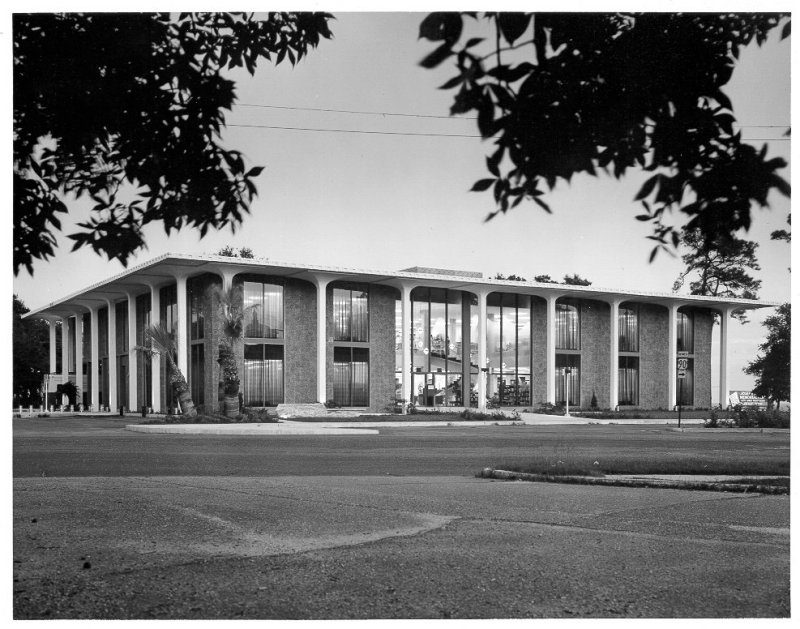
New Gulfport-Harrison County Library opens in downtown Gulfport (Harrison County Library System, "History of Our Libraries")
July 1966
Architecture / Interiors / Construction
The new Gulfport-Harrison County Library opens in downtown Gulfport to replace Gulfport-Carnegie Public Library. The library, designed by Arch. Charles L. Proffer under the style of New Formalism, stood in a plot deeded in perpetuity to Harrison County by Cap. Joseph T. Jones. The building cost $892,000.00 (around $7 million today), and was funded through bonds issued by Harrison County.10
2003
Demolition / Architectural and Engineering Services / Construction Management Services
The high-school gymnasium adjacent to the library is sold by The Gulfport School District to the Coast Transit Authority (CTA) for almost $2 million to build a parking garage.11
The building cost $6 million.12
*Listing of payments in agendas from Harrison County
August 2005
NAICS 541350: Building Inspections
Hurricane Katrina hits Gulfport. The library is flooded with up to 4 feet of water. Damage exceeds the 50% repair/replacement ratio, qualifying for demolition.13
According to usaspending.gov, inspections in Gulfport are conducted by Sherlock, Smith and Adams, Inc. under the contract GS04P06EXC0031 for $567,883.00 (NAICS code: 541350). Furthermore, Gulfport library begins to operate temporarily in Pass Christian out of a modular building donated for use by the Dupont Corporation.14
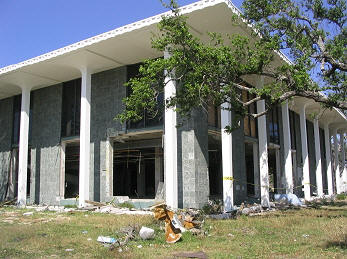
Gulfport Library after Hurricane Katrina (Gulf Coast News)
October 2005
Urban planning / Architecture
The Governor’s Commission for Recovery, Rebuilding and Renewal presents the “Redevelopment Master Plan Charrette Book.”15
The proposal has a strong focus on redeveloping the port, downtown Gulfport, and beachfront properties with a more commercial and touristic approach. HDR/LCA Sargent Town Planning prepares the report. Eley Guild Hardy is one of the architecture firms that participates. Also, the State approves new legislation (H.B. 45, 2005) that allows casinos to build within 800 ft. from the shore (roughly first line of blocks).16
2007
Gulfport Temporary Library opens in a trailer located at 47 Maples Drive, funded by the Bill & Melinda Gates Foundation and SOLINET.17
Harrison County applies for FEMA funding under the Public Assistance Program to demolish and relocate the Gulfport Library. FEMA offers up to $6 million dollars for the project. New coastal flood/elevation requirements limit the function of the library to the second floor, forcing demolition. They also force homeowners to move further inland, leaving beachfront plots open for real estate development. Furthermore, announcement of plans to redevelop the port, including the area around the library and Jones Park, heightens the real estate interest in the property.18
October 17, 2008
Building Inspection / Preservation
The Library of Gulfport is granted landmark status by the Mississippi Department of Archives and History.19
The application is submitted by “We the People,” a collective who opposes demolition.
December 2008
Urban planning
The Gulfport Redevelopment Commission (GRC) is created. Since their founding they have guided a series of investments along the beachfront and in downtown Gulfport, with the focus on resorts, hotels, casinos, and commercial projects.20
October 2009
NAICS 541330: Engineering Services
FEMA presents the Environmental Assessment Report for the Gulfport Library Relocation/Consolidation Project. The report, done by NISTAC under IDV contract HSFEHQ06D0489 for PA-TAC II services (NAICS:541330), presents one option for demolition and another for repurposing the library with help of a third-party investor. Ultimately, the latter prevails.21
June 2012
Architecture / Construction
The new Harrison Public Library in Orange Grove, designed by Eley Guild Hardy, opens. Contractor: Starks Contracting, Co.22
The library building is relocated, restored, and repurposed with Public Assistance from FEMA.23
2014
The city of Gulfport, through the GRC, begins to acquire land for the iconic project of the Mississippi Aquarium, which would be located next to the old library. The total cost of the land is $14 million.24
2015
NGIP 90657: Professional Architect Services, Land Development, Planning
In February, upon closeout of the FEMA funding used to relocate the Gulfport library in Orange Grove, Harrison County conveys the land to the City of Gulfport, who in turn declare it surplus and convey it to the GRC.25
Later in March, the GRC requests proposals for development of the Gulfport library site. (NIGP code: 90657).26
In April, The CTA signs the lease with the City of Gulfport (GRC) for $1.6 million. The land and property are a donation from the city, and incorporate the old library into the Aquarium project by becoming the new Transit Center, an extension of the parking garage built in 2003.27
August 2017
Architecture / Landscape Architecture / Civil Engineering / Structural Engineering / Fire Protection, Mechanical, Electrical Engineering
NGIP 90922: New Building Construction Services, Non-residential
The bidding process for general contractors begins (NIGP code: 90922).28
Eley Guild Hardy provides the final design, plans, and specifications.29
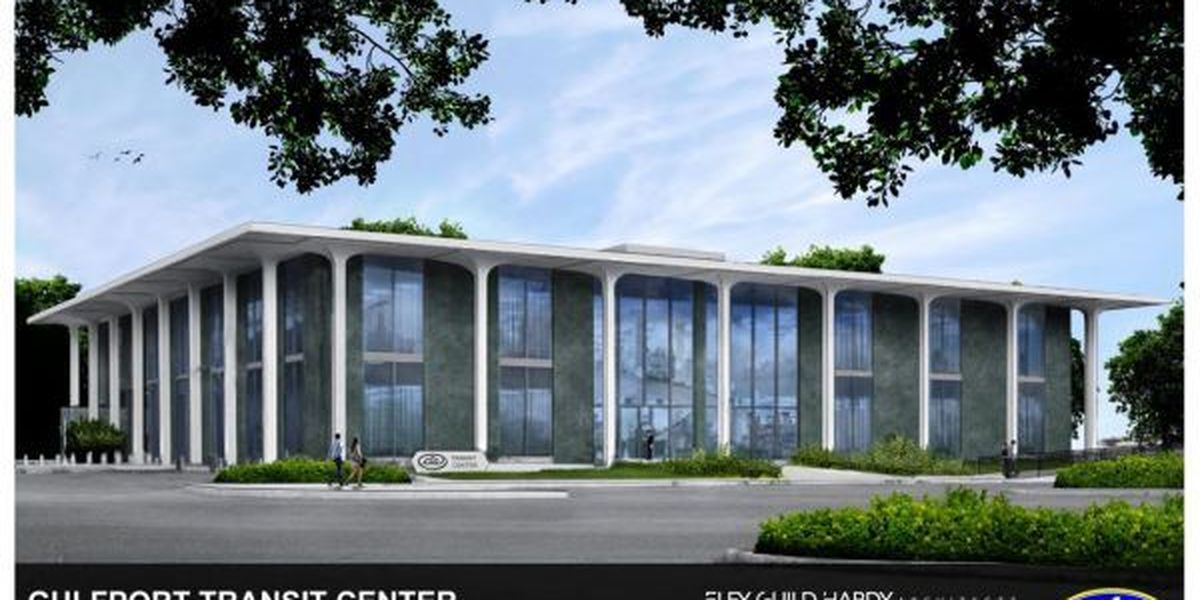
Exterior rendering of the CTA design, Eley Guild Hardy Architects. (WLOX)
2018
NGIP 90922: New Building Construction Services, Non-residential
Renovation begins. Roy Anderson Corporation is the general contractor. The total cost for the project is $8.2 million: $6,676,000 is awarded by the Federal Transit Authority through a grant program. The remaining amount is funded by the local CTA. In addition to the renovation, a $9,855,940-pedestrian bridge to connect the center with Jones Park is included in the project. $7,844,000 requested to the FTA, $2,011,940 from CTA.30
So far, $2.6 million is provided through federal grants.31
NOTES
- 1DeNeen L. Brown, “On Mississippi’s Gulf Coast, what was lost and gained from Katrina’s fury,” Washington Post, August 26, 2015, https://www.washingtonpost.com/local/on-mississippis-gulf-coast-what-was-lost-and-gained-from-katrinas-fury/2015/08/26/2c00956a-4313-11e5-846d-02792f854297_story.html?utm_term=.44d4fddc0009.
- 2“Louisiana Hurricane Katrina (DR-1603)”, FEMA, last updated November, 2005, https://www.fema.gov/disaster/1603; “Mississippi Hurricane Katrina (DR-1604), FEMA, last updated October, 2005, https://www.fema.gov/disaster/1604.
- 3The United States Census Bureau, “Community Facts”, American FactFinder.
- 4Haley Barbour, "Special Legislative Session and Gaming,” in America’s Great Storm: Leading through Hurricane Katrina (Jackson: University Press of Mississippi, 2015), 109-121.
- 5Campbell Robertson, “Mississippi’s Recovery After Katrina Holds Lessons for Policy Makers,” New York Times, August 28, 2015, https://www.nytimes.com/2015/08/29/us/mississippis-recovery-after-hurricane-katrina-holds-lessons-for-policy-makers.html.
- 6Richard Rainey and Katherine Sayre, “Downtown New Orleans history becomes post-Katrina real estate gold”, The Times-Picayune, August 27, 2015, https://www.nola.com/katrina/index.ssf/2015/08/downtown_new_orleans_history_b.html.
- 7It is not possible to track down the contracts through which Eley Guild Hardy Architects became involved with the project, but their designs were part of FEMA’s Environmental Assessment from 2009, the CTA project of 2003, and other project for the City of Gulfport according to official agendas from Harrison County meetings, http://www.co.harrison.ms.us/agendas/.
- 8This amount of money is mentioned by (1)Larry Banefield, former Harrison County board member as cited in American Library Association, “Post-Katrina Preservationists Fight On in Gulfport,” American Libraries, April 25, 2008, https://americanlibrariesmagazine.org/post-katrina-preservationists-fight-on-in-gulfport/;and by (2) Lisa Bradley, former manager of the Gulfport Main Street Association, as cited in Gwen K. Jones, “Demolition of Historic Buildings on the Mississippi Gulf Coast in the Wake of Hurricane Katrina” (Master’s thesis, University of Georgia, 2011), 91, https://getd.libs.uga.edu/pdfs/jones_gwendolyn_k_201108_mhp.pdf.
- 9Neel-Schaffer, Inc., Mississippi Gulf Coast Transit Development Plan 2016-2040 (Gulf Regional Planning Commission, 2016), http://www.grpc.com/wp-content/uploads/2015/06/Mississippi-Gulf-Coast-TDP-2016-2040-Final-Report.pdf.
- 10“History of Our Libraries,” About Us, Harrison County Library System, last modified February 20, 2009, https://harrison.lib.ms.us/about-us/history-of-our-libraries/.
- 11Brad Kessie, “Gulfport to Sell Frank Brown Gym for Parking,” WLOX, January 7, 2003, http://www.wlox.com/story/1074557/gulfport-to-sell-b-frank-brown-gym-for-parking/.
- 12Trang Pham-Bui, “Coast Transit Authority Ads Announce Big Changes Ahead,” WLOX, May 28, 2003, http://www.wlox.com/story/1298041/coast-transit-authority-ads-announce-big-changes-ahead/.
- 13NISTAC, Draft Environmental Assessment, Gulfport Library Relocation/Consolidation Project (FEMA, October 2009), 1.
- 14“Hurricane Katrina One Year Later,” Mississippi Libraries 70, no.3 (Fall 2006): 62.
- 15The Commission operates with $2 million in donations: $1 million from the John S. and James L. Knight Foundation, and the other million from Jim Barksdale. All architects, planners, and other professionals involved work as volunteers. Haley Barbour, America’s Great Storm: Leading through Hurricane Katrina, (Jackson: University Press of Mississippi, 2015), 103-130. A copy of the Charrette Book can be found in http://www.mississippirenewal.com/info/plansReports.html.
- 16Barbour, America’s Great Storm, 90-102.
- 17Harrison County Library System, “History of Our Libraries."
- 18Jones, “Demolition of Historic Buildings”, 90-91.
- 19“Gulfport-Harrison County Library,” Historic Resources Inventory Fact Sheet, Mississippi Department of Archives and History, https://www.apps.mdah.ms.gov/Public/prop.aspx?view=facts.
- 20Lynn Lofton, “Gulfport reaching out with new economic development effort,” Mississippi Business Journal, December 8, 2008, https://msbusiness.com/2008/12/gulfport-reaching-out-with-new-economic-development-effort/.
- 21“Environmental Assessment for the Gulfport Library Relocation/Consolidation Project, Harrison County, Mississippi (October 2009),” FEMA, last updated October, 2013, https://www.fema.gov/es/media-library/assets/documents/17028.
- 22“Portfolio,” Starks Contracting, Co., Inc., https://www.starkscontracting.com/news.
- 23“FEMA Assists Mississippi in Restoration of Harrison County Library in City of Gulfport”, FEMA, last updated June 12, 2015, https://www.fema.gov/media-library/assets/images/106739.
- 24Cassie Archebelle, “Gulfport takes steps to develop world-class aquarium,” WLOX, December 2, 2014, http://www.wlox.com/story/27528868/gulfport-takes-steps-to-develop-world-class-aquarium/ and Anita Lee, “Gulfport's Mississippi Aquarium would eclipse Coast tourist attractions,” Sun Herald, October 10, 2015, https://www.sunherald.com/news/local/counties/harrison-county/article38717829.html.
- 25City of Gulfport, “A Resolution by The Gulfport City Council to Declare Certain Property to be Surplus and to Authorize Conveyance of The Same to The Gulfport Redevelopment Commission,” February 2015, https://gulfportms.civicclerk.com/Web/UserControls/pdf/DocStream.aspx?ad=8110.
- 26“Procurement Details: # 104‐20150313152049 Gulfport,” Buying and Selling to Government in Mississippi, https://www.ms.gov/dfa/contract_bid_search/Bid/Details/1719.
- 27 David Elliot, “Work finally gets underway on CTA Transit Center in Gulfport,” WLOX, July 5, 2018, http://www.wlox.com/story/38580838/work-finally-gets-underway-on-cta-transit-center-in-gulfport/.
- 28“Procurement Details: # 100-20180119105308 CTA 16-010b / 3170008431.”
- 29It has not been possible to track down the contracts for this project by Eley Guild Hardy.
- 30Neel-Schaffer, Inc., Transit Development Plan 2016-2040.
- 31WLOX Staff, “Officials announce $2.6 million bridge project for downtown Gulfport,” WLOX, April 5, 2018, http://www.wlox.com/story/37891067/officials-announce-26-million-bridge-project-for-downtown-gulfport/.
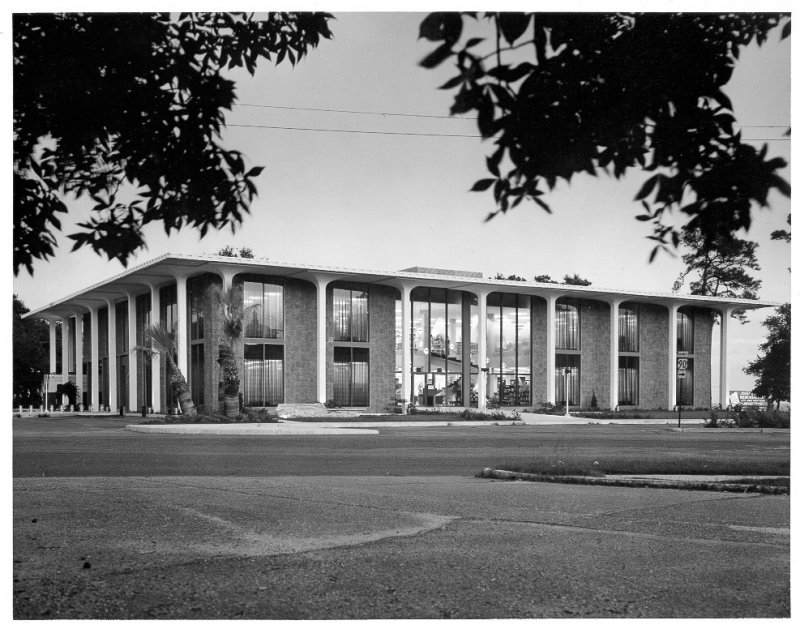
New Gulfport-Harrison County Library opens in downtown Gulfport (Harrison County Library System, "History of Our Libraries")
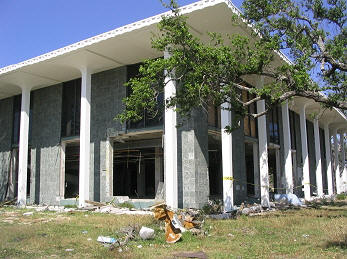
Gulfport Library after Hurricane Katrina (Gulf Coast News)
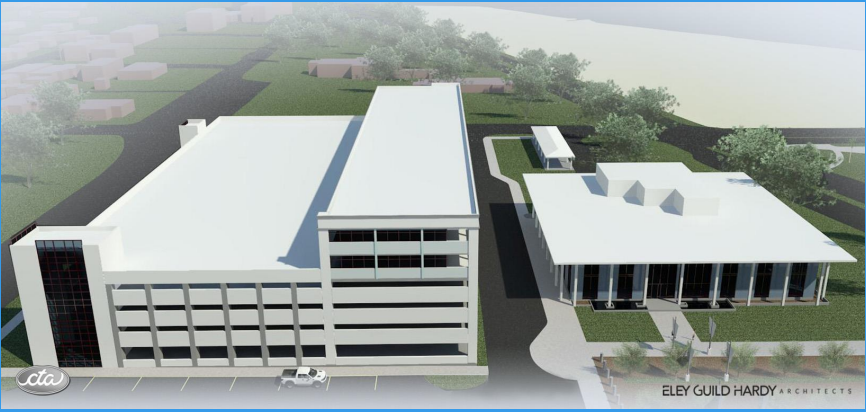
Exterior rendering of the CTA design, Eley Guild Hardy Architects (WLOX)

Mississippi Aquarium Design (Sun Herald)
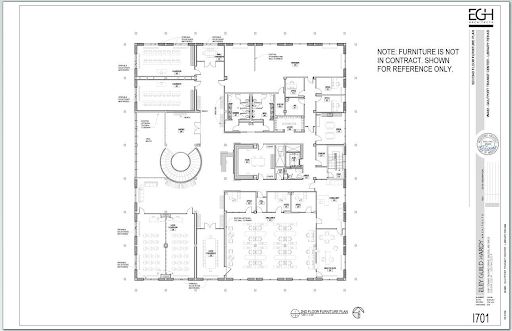
Plans (Eley Guild Hardy Architects Online Plan Room)
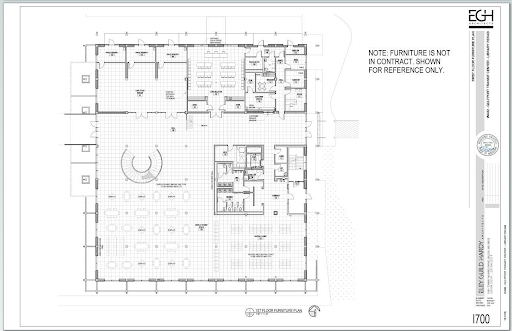
Plans (Eley Guild Hardy Architects Online Plan Room)
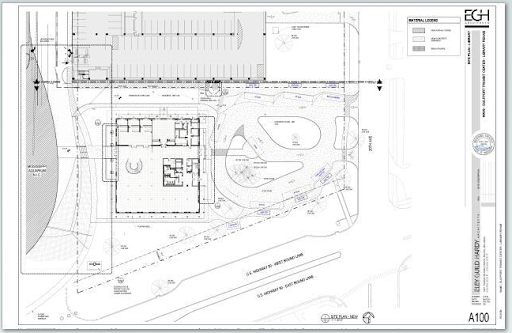
Plans (Eley Guild Hardy Architects Online Plan Room)
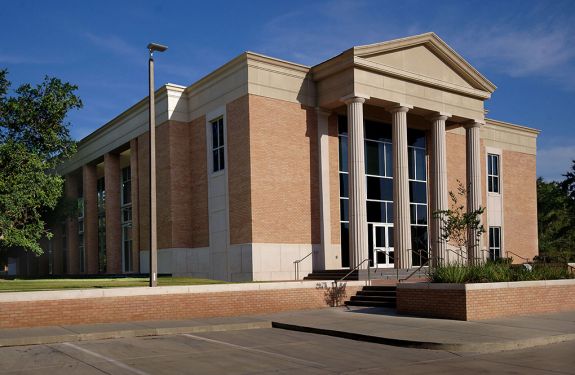
Gulfport Library Orange Grove, Eley Guild Hardy Architects (FEMA)